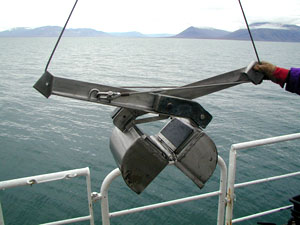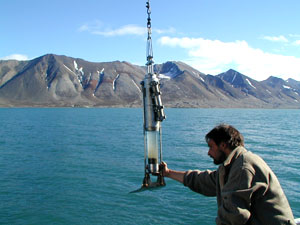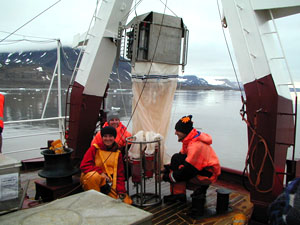8.1. Benthos
methods
- Stratified random sampling - for routine biodiversity monitoring. The strata are the predefined areas- zones of fjord as defined in figure in menu 2.1. Within each zone - stratum some 10 separated samples are collected to maximize spatial coverage.
- Nested sampling - permits to assess the patchiness of fauna distrubution.
Samples are collected with the replicates at increasing distances along straight line,
triangle or cross. Example from Kongsfjorden sampling in Dyrevika: Kendall et all 2002.
- Transects - permits to analyse faunal changes along selected environmental gradient e.g.
depth, distance from the glacier, etc. Example from Kongsfjorden: Scuba sampling in Hop et al. 2002.
- Station grids - permits to assess the distribution of fauna over larger area and describe
the occurrence of assemblages in spatial scale. Example from Kongsfjorden: Wlodarska et al. 2002.
gear:
 | | VAN VEEN |
 | | NIEMISTO |
- Van Veen grab 0.1 m2 with flaps,
for infaunal macrobenthos of medium size and restricted mobility (Mc Intyre 1980) as minimum 3 replicates are recommended, for single stations within
each zone minimum number of replicates is four.
- Epibenthic sledge for mobile epifauna and megafauna (Brattegard & Sneli 1974) - at least
10 minutes haul is recommended.
- Suction sampler for meiofauna of 10 cm2 area - 3 replicates.
- Niemisto sediment corer - for short (40 cm) sediment cores.
- Frame with suction devise for scuba divers.
fixation & sorting
- Macrofauna: 4% sea water buffered formaldehyde, 10% for presorted samples with remaining
sediment, 0.5 mm sieves for macrofauna.
- Meiofauna: 3% sea water buffered formaldehyde, set of 0.5; 0.2 and 0.047 mm sieves for meiofauna.
- Practical tip: since majority of infauna occurs within upper 5cm of sediment it is recommended to remove the upper layer of sediment from the open grab and gently sieve it separately. That secures delicate animals from washing in the large amount of sediment and speeds up the sorting procedure.
8.2. Plankton
method:
- Long Term Plankton Observation - Kongsfjorden transect,
Hornsund transect,
Bjornoya-Sorkapp transect. Stratified vertical hauls ithin distinct
CTD layers - usually surface water 0-20 m,
subsurface 20-50 m, intermediate 50-100, deep 100-300 m.
Ref: Kwasniewski et al. 2002
gear:
 | | MULTINET |
- Multinet 180- 200 µm mesh for mesozooplankton (0.2 to 5 mm in length)
- WP-2 net with 180-200 µum mesh for mesozooplankton (0.2 to 5 mm in length)
- Tucker Trawl with 10 mm meshmesh for macroplankton (animals 5 to 30 mm in length).
fixation & sorting
- 4% sea water buffered formaldehyde
samples are filled to even volume of 250 cm3, macroplankton is selected from
the whole samples, mesozooplankton is identified from 5 subsamples of 10 cm3.
Splitter for subsamples selection is recommended.
|

